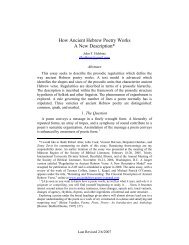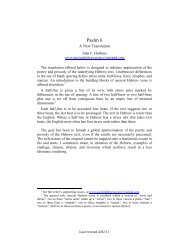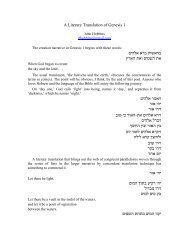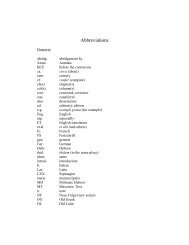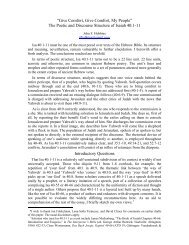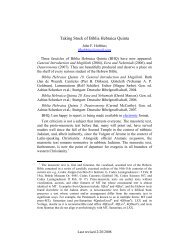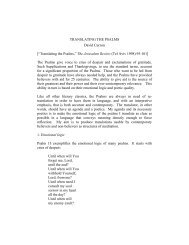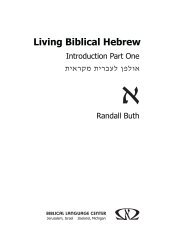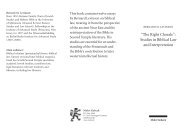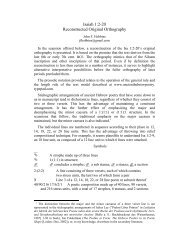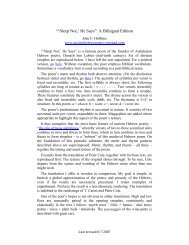Here - Ancient Hebrew Poetry - Typepad
Here - Ancient Hebrew Poetry - Typepad
Here - Ancient Hebrew Poetry - Typepad
- No tags were found...
Create successful ePaper yourself
Turn your PDF publications into a flip-book with our unique Google optimized e-Paper software.
26Varieties of <strong>Ancient</strong> <strong>Hebrew</strong> VerseAggregate, not average syllable counts allow parameterization of varietiesof ancient <strong>Hebrew</strong> poetry. Three meters or systems of constraint areidentifiable.In common meter - most extant ancient <strong>Hebrew</strong> verse is written in it - thelength of versets and lines, with post-stress syllables not counted, isconstrained as follows: a verset contains no less than 2 but no more than 10syllables (absent the constraint, it might contain up to 18); a bipartite line, noless than 6 but no more than 18 syllables; a tripartite line, up to but no morethan 24 syllables. Common meter is flexible but still constrained. Examples:Isa 1:2-20; 40:1-11; Zeph 1-3.Qinah meter is more severely constrained. The “a” verset in a bipartiteline normally contains 5 to 8 syllables, the “b” verset 3 to 7 syllables; in atripartite line, each verset contains 3 to 5 syllables. Lines contain 9 to 14syllables. Qinah poetry is dominated by lines with a shorter or syncopatedsecond half, where “halves” or “half-lines” are defined as the text on eitherside of the major caesura (in a three verset line, the third or “c” versetconstitutes the second half). Occasionally, halves are equal in length; rarely,the second half is longer than the first. A 3:2 line is typical, but syncopationmay be achieved in more subtle ways. As a rule, lines with halves of equallength or a second half longer than the first by prosodic word count have ashorter second half in terms of syllables and/or absolute words.Compensation also occurs in reverse, such that lines with halves of equallength or a second half longer than the first by syllable count as a rule have ashorter second half in terms of prosodic words. Examples: Lam 1-4; Jon 2:3-10.Mashal meter is dominated by lines with half-lines of approximatelyequal length, where “half-lines” are defined as the text on either side of themajor caesura as above, and “approximately equal” is defined as plus orminus 3, or in some cases 2 syllables. Versets are characteristically 4 to 8syllables in length. Examples: Prov 1:10-33; 2:1-22; 8:1-21; Pss 111-112.Syllable counts reflect phonological length the parameters of which mayreflect time worn convention rather than systematic counting. Judgments onthe part of the individual poet were probably involved, but measurement ofcomposed in what the Greeks call heroic meter,” that is, “hexameters consisting of sixteensyllables” (Praep. ev. XI, 5), the practice of counting the syllables of ancient <strong>Hebrew</strong> verseis at least as old as the comparative study of Greek and <strong>Hebrew</strong> poetry.



